#citystream
Explore tagged Tumblr posts
Text
In Fonfuka, residents are celebrating the completion of two major bridges over the Mbuk and Nguma rivers, notorious for their danger and the obstacles they've posed to development.
Bakah Derick and Nji Ignatius have this report for you from Fonfuka for The CityStream Online TV
https://youtu.be/LapyhHewYlA?si=-jE-YYPnquSyOmho
0 notes
Photo

CityStream: Seattle’s Trashy History - YouTube
0 notes
Photo

Sam’s GDC Recap: Day 2
All right, here we are to review Day 2 of GDC, Tuesday February 28. Today was another day chock full of talks. I was on a Summits, Tutorials, and Bootcamps pass, which primarily take place Monday-Tuesday, so I was trying to make the most of the talks I could get to. I still did have a little discretionary time, and met a few nice people. Let’s get into it.
(And check it out! It me! Photo courtesy of Tim Rogers’ Twitter.)
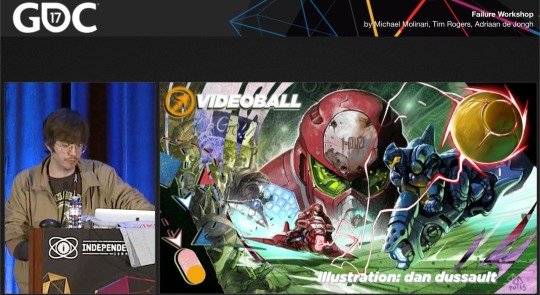
Failure Workshop
Speakers: Michael Molinari, Adriaan de Jongh, Tim Rogers
Overview:
Michael Molinari talked about his interactive Twitch game CityStream
A city building game that combines elements of idle games, Twitch Plays, and realtime DMing
Reasons the game didn't do well included:
Paid content was permanent, so no reason to keep buying
Had to work double shifts to run the game live (more on this in Details)
Got too confusing as more and more things were added
Adriaan de Jongh talked about closing down his game studio Game Oven
Discussed background of the studio and costs of keeping it open
Various struggles for the team:
They had different deep motivations (for the kinds of games they wanted to make, and how to run the studio)
Media articles often gave credit solely to Adriaan, not the rest of the team
Their roles were undefined, which caused tension
Tim Rogers talked about the failure of his digital sporting good VIDEOBALL
In some sense, Videoball was not a failure, because Tim designed his own favorite game
Videoball was already super hype in 2013
Took too long to get the game out, and had a weak message (I thought the trailers were awesome though - Ed.)
Various problems that contributed to the game's failure:
Inherited the burden of a publisher's expectations (to make the game bigger and better)
Divided their work into "have-to's" and "want-to's" (which led to moving the “want-to’s” into overtime work)
Original publisher went out of business during production
The first-time game experience for new players was too difficult, and often in the wrong environment (they intentionally prioritized a player's 1000th experience over the 1st, which led to the game's appeal not being apparent at first, especially in 1v1 like many streamers and Let's Players did)
Too much stuff in the game (online play split matchmaking into ranked and unranked 1v1, 2v2 and 3v3, plus arcade mode etc.)
The menus were not perfect (e.g. confusing at some parts)
Spent much less than $1 mil promoting the game
Lessons learned from the game:
The game was great: we can make great games
Game conventions are loud and stupid: we should have shown at universities, etc.
You can't make eSports, it just happens (shouldn't have diluted matchmaking with so many modes and just had ranked 2v2, which is what the game was designed around)
We could have made a dumber game (with more identifiable characters, etc)
Gave ideas on how we can save Videoball (essentially a stripped down, ad-supported free version)
Interesting details:
CityStream was only playable in one place: the CityStream Twitch channel. Now that the game has ended, there's no way for anyone to play it.
CityStream's character BEEP, a robot who narrated the action, was actually played in real-time by the team. They watched the game every day with the players and wrote live responses, because they weren't able to come up with a good automated solution. This led to double shifts where the team worked on the game during the day, and then played the game on stream at night.
CityStream ended with a really cute event where players flew to the moon while riding atop the city they built
The business model of Game Oven was to run a company on the "long tail" of sales from many games.
It cost approximately 6500 euros per month to run Game Oven, which went to 3-4 full-time employees, contractors, and other costs.
In the end, long tail sales wasn't enough to run the company, but other sources helped them make it. In other words, Game Oven wasn't closed because they ran out of money.
Communicating your vision and your frustrations is hard, but important
Despite all the problems, Adriaan is still friends with Bojan, and he's proud of what the team accomplished together
"Videoball launched, and my life has been a garage sale ever since." - Tim Rogers
With VIDEOBALL, Tim wanted to create the Burberry scarf of video games (iconic, high-quality, premium)
When working 16-hour days at some point during development, Tim worked out that they were probably making 4.60 per hour
People have said VIDEOBALL's design style is "preschool industrial," and called the game itself "Pong for millenials" and "2D Rocket League"
Tim showed an awesome illustration by Dan Dussault of what VIDEOBALL could look like if the look was un-abstracted into armored future soldier sports
Thoughts:
Failure Workshop sounds like a pretty depressing talk, but it actually wasn't too much of a downer. I mean, I don't want to downplay it: it's hard to see the struggles people went through, and you wish they could have succeeded. And it's also scary to realize that your chances for failure as an indie dev are also very high.
Fortunately though, the speakers generally had a positive outlook. It was good to see that they could pull lessons out of their experience, and they were still at it, trying to make games. CityStream and a lot of the games from Game Oven were very unique and creative, so it was cool to see a lot of new ideas, even if all of them didn't work out. And Tim Rogers' talk in particular was one of the funniest I went to at GDC. Definitely some of the best crowd response I saw.
Links:
Failure Workshop (Video) on GDC Vault: The full talk is available for free on the GDC Vault!
Failure Workshop (Michael Molinari Slides) on GDC Vault
Failure Workshop (Adriaan de Jongh Slides) on GDC Vault
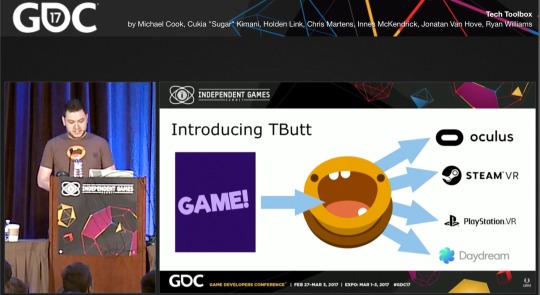
Tech Toolbox
Speakers: Michael Cook, Holden Link, Brian Williams, Cukia "Sugar" Kimani, Chris Martens, Innes McKendrick
Summary:
Michael Cook of Falmouth University showed a procedural assistance tool called Danesh
A tool designed to help you tune your procedural generation
Allows you to not only adjust parameters and see examples, but also calculate metrics
Autotuning lets you set desired output metrics rather than mess with inputs to try to get those outputs
Danesh can search your code for other potential parameters to include
Available at danesh.procjam.com
Holden Link of Turbo Button showed off Tbutt, a wrapper for VR SDKs in Unity
Makes it really easy to compile builds for different VR platforms
Helpful for testing a project for a specific platform on whatever VR rig you have handy
For example, rather than compiling a build to load onto mobile for Google Daydream or Cardboard, the Turbo Button team can just flip a switch to test what they're working on with the Vive on their desk
Available at github.com/turbobutton/tbutt-vr-framework
Brian Williams of Spry Fox demoed Dark Config, a tool that allows real-time changes while the game is running by hotloading config files
You can define level attributes in config files and change those files on the fly, and the game will update instantly while running
This allows much faster iteration and proofing out new ideas using new combinations of existing assets
Uses YAML for the config files
Works with Unity or any other C# project
Available at github.com/spryfox/DarkConfig
Cukia "Sugar" Kimani talked about using Bezier curves to animate rectangles
From Johannesburg, South Africa, working in a studio called Nyamakop on Semblance
Talked about animating the main character, a little blobby dude, by deforming a rectangle using Bezier curves
(Wasn't able to get down many details, but it looked pretty neat)
Is winning the email game with an address that starts with "holla@yourboy" haha
Chris Martens showed Ceptre, or TinkerTool for rulesets
It's a small prototyping language for rulesets and logic stuff in board and video games
Could be helpful for testing resource economies (like Minecraft crafting), procedural generation (like Spelunky) or interactive fiction
Available at github.com/chrisamaphone/interactive-lp
Innes McKendrick from Hello Games talked about the texture generation in No Man's Sky
Their goals were to create variety, allow for runtime generation, and amplify the work of a small art team
They mix and match different layers and elements (base color, stripes/spots, hair, etc.) of individual textures created by an artist
Wrote a photoshop script to export color maps and metadata
For better color control, don't work in RGB (they use HSV)
The game loads in artist data, then combines and recolors in the shader, and finally generates a mipmap
They also wrote tools that let artists see lots of examples generated from their work, so they can make tweaks
Thoughts:
There were some very interesting tools in here. I was particularly into TButt, as it seems like it would be very useful for friends of mine that work on VR games in Unity. Danesh and Dark Config also seemed very useful, and using Bezier curves as an animation tool was interesting too.
Links:
Tech Toolbox (Video) on GDC Vault: Available for free!
Tech Toolbox (DarkConfig Slides) on GDC Vault
Tech Toolbox (Rectangles Slides) on GDC Vault
(The links to each tool are included in the summary notes, if provided.)
Lunch break!
After the Tech Toolbox talk, I got to talking with the guy next to me, Austin. He's a really friendly grad student from University of Michigan who co-teaches the only game development-related class at the school. He invited me to grab lunch with him and some friends, which included his game dev co-teacher Kurt, some grad students from Carnegie Mellon, and Rodrigo, an audio engineer and developer from WayForward. We went to Mel's Diner for lunch (where I got a old-school syrupy strawberry lemonade and a few very juicy, red-to-the-point-of-being-disconcerting sliders), and had a pretty fun time talking about Undertale, Splatoon, the Switch, etc. While Rodrigo and I were talking, I was excited to be able to tell him about Thumper, which he hadn’t heard of yet. If you're out there Rodrigo, hope you checked it out! Let me know what you think!
Unfortunately, lunch went a bit longer than I expected and I missed a talk by Matt Thorson (creator of Towerfall) about the level design for Celeste. Instead, I wandered around a bit in Moscone West until the next talks started, and ended up talking to Josh and Marcos, two Aggies who are currently working as generalists in the games industry (at Flying Car Games, I think?).
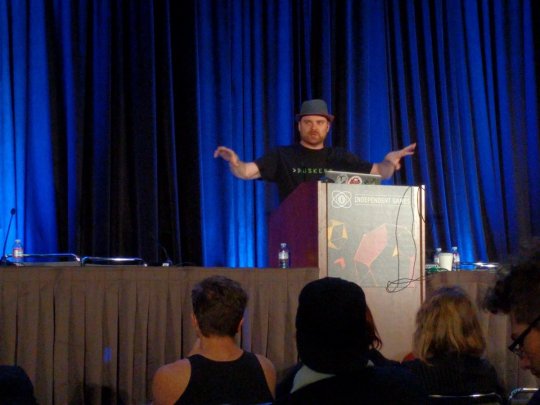
Finding ‘Duskers’: Innovation through Better Design Pillars
Speaker: Tim Keenan
Main points:
Rather than designing Duskers up front, the design of the game emerged during the course of development as Tim tried to listen to what the game needed
He gradually discovered several design pillars that guided development, but these pillars were less like mechanics or principles and more like emotions or feelings he wanted to evoke
These pillars included: realism, isolation, and careful planning
Tim felt that staying true to these pillars in all of his decision-making is what led to the effective communication of these feelings in the final game
Interesting details:
Duskers was very much inspired by Capsule, a similar terminal-based game set in space. (In fact, I was a bit confused when I first heard about Duskers, because I had heard of Capsule and wasn't sure if it was the same game.)
He was tempted to flesh out the look of the game world by showing a view of the area around the player's computer terminal before the game began. In the end, he decided to only show the on-screen display, in support of the realism pillar. The idea is that the player isn't controlling a drone operator character, they are the drone operator. This 1:1 simulation of the terminal helped players to feel like they were really there when they turned out all the lights and played.
Similarly, he tested two ways of showing what each drone "sees": a CCTV-like camera feed, and a less-readable view based on edge detection, which is closer to methods used in real computer vision for robots. Players liked the CCTV version more, but he chose the edge detection view, again to support the pillar of realism.
He also cut music entirely from the game to make it feel more real, which was a particularly scary decision.
Tim encouraged anthropomorphizing of the drones, which he hoped would make players feel like a lonely, slightly crazy freighter pilot. He gave each drone a name, and opted to let the drones obey orders blindly, rather than give them some level of AI autonomy. This made the drones feel more like pets or children than peers. He hoped that players would grieve the death of a drone, then realize how crazy they were being for attaching feelings to unfeeling robots, just as a drone operator in the game's world would.
He also increased the feeling of isolation by using logs to flesh out the game's world instead of direct dialogue with other characters.
Thoughts:
As someone who's really interested in imbuing games with emotion and feelings, Tim's success in achieving this with Duskers was really encouraging, and he had some good ideas on how others could do the same. The talk itself was engaging too. I recommend checking it out, especially if you're a fan of the game.
Links:
Finding ‘Duskers’ (Video) on GDC Vault
RUN and RUN / lyrical school 【MV for Smartphone】 on Vimeo: Speaking of 1:1 interface simulations, I was reminded of this great music video, which is designed to be watched on your smartphone (ideally an iPhone). If you’re on your desktop, go ahead and open it up on your phone. I’ll wait ;)
Fantastic Arcade 2016: Misfits Attic’s Sci-Fi Drone Sim DUSKERS - YouTube : Tim’s talk at Fantastic Arcade, which looks to cover some of the same content, and more!
How the dev behind Duskers let his game be what it wanted to be on Gamasutra : a Gamasutra Twitch interview with Tim that also looks like it touches on the same themes of the talk.
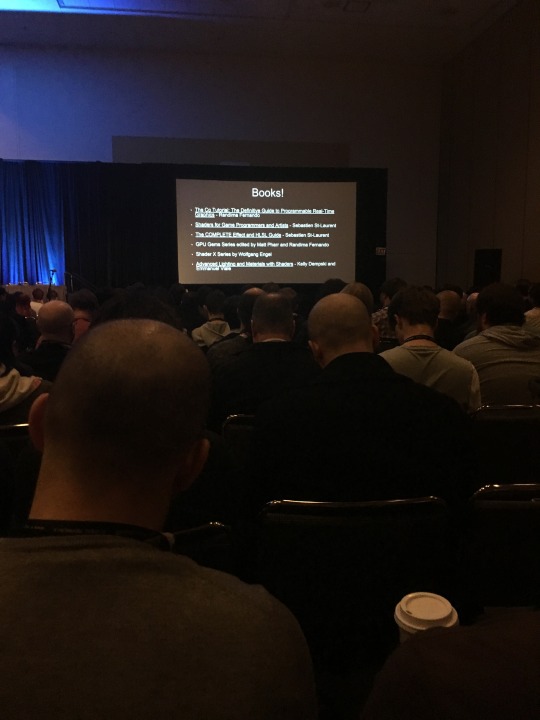
Shaders 201: Creating Art with Math
Speaker: Ben Cloward
Main Points:
Demoed methods for creating several shader effects, including:
A simple cloth shader
Animated rain ripples
A volumetric effect for something like ice with dirt and imperfections inside
Thoughts:
I thought this talk was fairly good, but it covered ground that I was already somewhat familiar with. The methods he described were fairly simple, and I’ve learned similar things about shaders in school already. The descriptions are a bit technical though, and I don’t remember most of it, so I won’t spend a ton of time on this talk. However, I will share some of the resources he mentioned in the links below.
Links:
Unfortunately this talk is members only on the Vault.
Uncharted 2: Character Lighting and Shading (Slides) : Ben cited this SIGGRAPH 2010 talk as the basis for the cloth shader he demoed.
Water drop 1 – Observe rainy world | Sébastien Lagarde : A series of blog posts that was the basis for the animated rain ripple shader demo.
Efficient Shader Tricks (Slides) : This GDC 2006 talk was the reference for the volumetric shader.
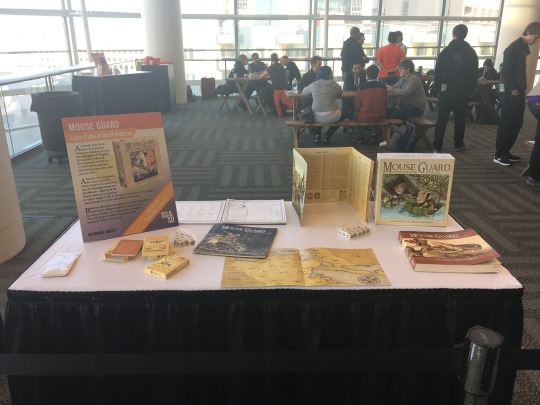
Another break
After this, I nearly went to the talk “Bringing Fantasy to Life in ‘Final Fantasy XV’”. Actually, to tell the truth, I actually got in the room for the talk, heard the speaker say that there would be spoilers, and then left (after a discrete pause so people wouldn’t think I was leaving for spoilers :P haha). In other circumstances I might have just stayed, but I’ve actually bought Final Fantasy XV and plan to play it soon, so I decided to abstain.
Instead, I went by the Shut Up and Sit Down board game lounge. I saw a few interesting games there, like the beautiful-looking Mouse Guard RPG. I think the comic series is really neat, and I’ve been seeing great reviews of the RPG as well. I was also intrigued by Beyond Baker Street, which was described as a Sherlock Holmes-themed Hanabi where you play a group of inept detectives trying to beat Mr. Holmes to the punch. I do love me some Sherlock.
While there, I ran into my friend Jon, co-designer of the board game Skulldug! and host of the podcast Pretentious Game Ideas. We both worked at Microsoft Studios a few years back, but both moved on to different things. It was nice to catch up. He also told me about Bargain Quest, a game he had been watching a playthrough of. Apparently you play as competing shopowners in a fantasy adventuring town, which sounded pretty neat.
After that, I headed downstairs and chilled with my travel buddy Brian until the last talk of the day, the Indie Soapbox.
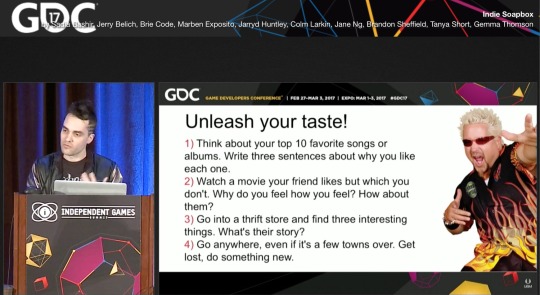
Indie Soapbox
Speakers: Brandon Sheffield, Tanya X Short, Jarryd Huntley, Sadia Bashir, Marben Exposito, Gemma Thomson, Jerry Belich, Brie Code, Colm Larkin, Jane Ng
Brandon Sheffield: Taste in Games
Brandon encouraged the crowd to make more games that are different by showing their tastes and passions
Doing this can be risky, but can yield greater artist rewards
Cultivate your taste by:
Thinking about your favorite things
Asking others about their favorite things, and why
Going out in the world and doing something new
Going to the thrift store and finding 3 interesting things
Unleash your taste by making something that means something to you, not something bland and flavorless
(Kudos for the Guy Fieri cameo)
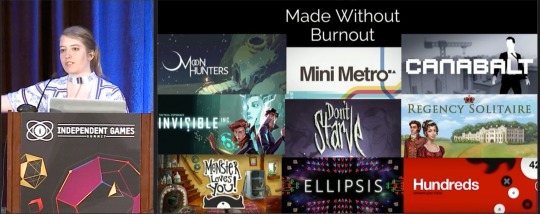
Tanya X. Short: How to Self-Care AND Meet Hard Deadlines
Your goals are:
Don’t burn out (making a great game is NOT your #1 priority)
Keep making games better each time (so you have to survive!)
Make a great game
It’s hard to take care of yourself, but believe you can do it
Moon Hunters, Mini Metro, Canabalt, Don’t Starve and more were made without burnout
Stop working all the time (and set specific work hours, it will actually increase productivity)
Prioritize and reprioritize, try to cut out the stuff that’s urgent but not important
Estimate how long it will take you to do tasks, then evaluate the actual time after
Cut the scope of your game before you bleed out
3 weeks of 60+ hours is proven to be less productive than 3 weeks of 40 hours
You’re not an exception
In a study of people who think they need less than 7 hours of sleep, only 5 out of 100 were correct
Don’t give up, forgive yourself for mistakes in self-care and move on
Lack of exercise should be one of the biggest worries, put your health first
Protect your love and joy and energy and don’t use it up by trying to feel more productive
Jarryd Huntley: Indie Rock - The Indie Cousins You Didn’t Know You Had
There are things indie game devs can learn from the indie rock scene
Like rock musicians, you don’t get started until you actually pick up the instrument. Just do it.
Try to take inspiration from wide life experience, not just “game X + game Y”
Work together and hire indie musicians for your game
Try making a local art manifesto with other independent artists in your area, maybe go on tour with a band
Try to learn from other fields that have similarities to indie game development, and support those people too
Sadia Bashir: 3 Things That Can Save Indies from a Pitfall
We think that our great idea is what makes our game successful, but what is really tied to success?
Conceptualize and plan at an early stage
Freeze requirements and scope throughout to avoid feature creep
Quality of a product is related to quality of development process
A hybrid process might be more successful than Agile
Marben Exposito: Subverting Expectations in Shower with Your Dad Simulator 2015
Develops a lot of short, silly games based on dumb Twitter suggestions
Finds it effective to mix the weird and mundane
Also effective was to subvert expectations
Added surprise secret game section, which people really liked
Gemma Thomson: Owning Your Place
The public perception of indies can be harmful
Often we see it as white men crunching on games in a bedroom
Sometimes we end up glamorizing bad working conditions
But life isn’t really Indie Game: The Movie, not everyone can afford to work like this
In our public and private conversation, we should a promote more realistic idea of game development
Jerry Belich: Venn Harder
Currently, the overlap between academia and industry is not too large
Contribute your passion to students
Help students learn more about design than just learning the tools
Opportunities include adjunct teaching positions, short-term teaching residencies, or collaborating with faculty
Brie Code: Public Speaking
Brie shared some tips for preparing to speak publicly
Remember “Why do I care?” and who the audience is
Create an outline (why I care, what I’m saying, why I’m saying it)
Use tips from “Can Charisma Be Taught?” study
Only one idea per slide
Pictures, not text
Practice a lot (and remember to breathe)
Realize you might always be anxious because it’s normal, redirect energy into the talk
Colm Larkin: Share Your Games
Colm developed in the open from day 1 on TIGSource, sharing early progress
Got good feedback, helped him get confident
A few related tips:
Your idea is not that special: execution is more important than the idea
No one is going to steal your idea (and if you do, you’ve been sharing the whole time)
Share work embarrassingly early, before you’re ready
It’s hard, but it helps
Get feedback before you get too far in
Get feedback on foundational stuff, not just polish stuff
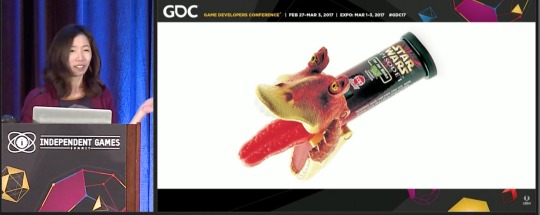
Jane Ng: “Product” and Why That Shouldn’t Be a Dirty Word
Jar-Jar tongue candy: a terrible product
Often we don’t like talking about our art as a product, but it’s important to success
We don’t usually give feedback on “would you pay money for this?”
Consider experience not just for the player, but for the potential player
See making a good product as a design problem
Think about what makes a great entertainment product
Make sure the whole package is attractive to a potential player
And make sure your game isn’t a Jar-Jar Binks candy tongue
Thoughts:
I had a great time at this talk. Really rapid fire talks, and everyone had an interesting point to make. A few good laughs too. I highly recommend checking this one out on the Vault.
Links:
Indie Soapbox (Video) on GDC Vault: Available for free!
Talks I missed
Building Game Mechanics to Elevate Narrative in Oxenfree - Would like to check this one out after I play Oxenfree. Check it out on the free Vault!
Friendship, Curiosity & Challenge: Focusing Your Career as an Indie Dev - Also seems interesting, and also free to all.
Board Game Design Day: The State & Future of Board Game Design - I don’t follow the board game industry as closely as the video game industry, though I like playing board games. I’m interested to hear what was said here.
Board Game Design Day: The Making of 'Pandemic Legacy' - Also very interested in this, since Pandemic Legacy has been getting tons of praise. I’m scared of spoilers until I have a chance to play though.
Post-con activity
After the Indie Soapbox, Brian, his teammate Colton, and I went out to eat at Tropisueno, a fairly decent Mexican place very close to the Moscone Center. I got to hear a bit from Colton about his background and how his studio, The Stork Burnt Down, got founded, which was interesting.
After dinner, Brian and Colton went to the Oculus party across the street, which was invite-only. I had been considering going to a chiptune show at the DNA Lounge, but was again feeling pretty exhausted. So I headed back to the room to chill and play some Ace Attorney 5. A very full day.
#gdc 2017#gamedev#gdc17#video game writing#videoball#citystream#Game Oven#Duskers#Shut Up and SIt Down#gdc recap
0 notes
Photo

http://www.seattlechannel.org/CityStream/segments?videoid=x99739
#the go for broke spirit#nisei veterans#442nd#100th Battalion#us army#wwii#eo9066#japanese internment
1 note
·
View note
Video
youtube
CityStream: Pacific Northwest Ballet's The Nutcracker

The Ballet is important in Pacific Northwest

0 notes
Video
citystream da marika albanese Tramite Flickr: london, uk
4 notes
·
View notes
Text
MIPoPS featured on the Seattle Channel!


MIPoPS and the Southwest Seattle Historical Society’s Log House Museum were just profiled by the Seattle Channel! They put together a fantastic piece on video preservation and why it is so important, as well as the exciting stories being re-discovered through this reformatting project! You can watch the piece on the Seattle Channel’s CityStream here: http://www.seattlechannel.org/videos?videoid=x102595
0 notes
Text
CityStream: New Denny Substation
https://www.reddit.com/r/SeattleWA/comments/bsb880/citystream_new_denny_substation/?utm_source=dlvr.it&utm_medium=tumblr
0 notes
Photo

WENGER CityStream 16 Zoll Notebook Aktentasche mit Tablet-Fach 12,9″ schwarz Preis : 71.98 € jetzt kaufen Artikelmerkmale Artikelzustand: Neu mit Etikett: Neuer, unbenutzter und nicht getragener Artikel in der Originalverpackung (wie z.
0 notes
Text
Robert Horton runs down movies filmed in Seattle
As far back as the 1930’s, the beauty of the Emerald City has proved an irresistible gem to Hollywood producers and directors, who have made Seattle the backdrop for all kinds of popular films. Lately Seattle has been on the small screen with Grey’s Anatomy, but CityStream reporter Robert Horton takes a look at the […] from Seattle Palette https://seattlepalate.com/films-theatres/robert-horton-runs-down-movies-filmed-in-seattle/
0 notes
Text
Nexar CityStream Uses Smartphones To Crowd-Sourced Mapping Data For Cities And Self-Driving Cars
Nexar CityStream Uses Smartphones To Crowd-Sourced Mapping Data For Cities And Self-Driving Cars
Dashcam app maker Nexar wants to leverage the smartphones that millions of drivers already own to turn vehicles into sensors that visually scan the road to provide mapping data for cities and self-driving cars.
read entire article on Forbes – Autos
View On WordPress
0 notes
Link
via Twitter https://twitter.com/RachelRosenson
0 notes
Photo

CityStream: The Paramount’s Mighty Wurlitzer - YouTube Sound & Music https://www.youtube.com/watch?v=aeUrLMMSWHI
0 notes
Photo

https://goo.gl/Bxrc2w CityStream gives cities real-time road data http://dlvr.it/P5p8JK
0 notes
Link
CityStream gives cities real-time road data | TechCrunch : http://tcrn.ch/2prbNIz
0 notes
Photo

CityStream gives cities real-time road data CityStream from Nexar harnesses the company’s dashcam app and allows municipalities to make use of the crowdsourced data.
0 notes
